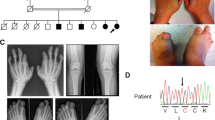Abstract
Proximal symphalangism (SYM1) is an autosomal-dominant developmental disorder of joint fusion. This disorder is best known from famous historical descriptions of two large kindred: Cushing’s description in 1916 of the “straight-fingered” Brown family of Virginia and Drinkwater’s description in 1917 of the British Talbot family of noble blood, descended from the English war hero John Talbot, the first Earl of Shrewsbury (1388–1453). Recent genetic studies link this phenotype to expression of abnormal genes at future joint sites: too little expression of NOG, a growth antagonist, or overexpression of GDF5, a growth agonist, results in cartilage overgrowth and bony fusion. This review unites in depth the first historical accounts of SYM1 with a clinical description and reviews the current understanding of the molecular mechanism underlying what is likely the oldest dominant trait ever studied.









Similar content being viewed by others
References
Cushing H (1916) Hereditary anchylosis of the proximal phalangeal joints (symphalangism). Genetics 1:90–106
Strasburger AK, Hawkins MR, Eldridge R et al (1965) Symphalangism: genetics and clinical aspects. Bull Johns Hopkins Hosp 117:108–127
Drinkwater H (1917) Phalangeal anarthrosis (synostosis, ankylosis) transmitted through fourteen generations. Proc R Soc Med (Sect Pathol) 10:60–68
Elkington SG, Huntsman RG (1967) The Talbot fingers: a study in symphalangism. Br Med J 1:407–411
Geelhoed GW, Neel JV, Davidson RT (1969) Symphalangism and tarsal coalitions: a hereditary syndrome. J Bone Joint Surg Br 51B:278–289
Maroteaux P, Bouvet JP, Briard ML (1972) La maladie des synostoses multiples. Nouv Presse Med 1:3041–3047
Brunet LJ, McMahon JA, McMahon AP et al (1998) Noggin, cartilage morphogenesis and joint formation in the mammalian skeleton. Science 280:1455–1457
Gong Y, Krakow D, Marcelino J et al (1999) Heterozygous mutations in the gene encoding noggin affect human joint morphogenesis. Nat Genet 21:302–304
d’Escouchy M (1863) Chronique de Mathieu d’Escouchy, vol 2 (edited by G du Fresne de Beaucourt). Mme Ve J. Renouard, Paris, p 39
Seemann P, Schwappacher R, Kjaer KW et al (2005) Activating and deactivating mutations in the receptor interaction site of GDF5 cause symphalangism or bradydactyly type A2. J Clin Invest 115:2373–2381
Author information
Authors and Affiliations
Corresponding author
Rights and permissions
About this article
Cite this article
Plett, S.K., Berdon, W.E., Cowles, R.A. et al. Cushing proximal symphalangism and the NOG and GDF5 genes. Pediatr Radiol 38, 209–215 (2008). https://doi.org/10.1007/s00247-007-0675-y
Received:
Revised:
Accepted:
Published:
Issue Date:
DOI: https://doi.org/10.1007/s00247-007-0675-y




